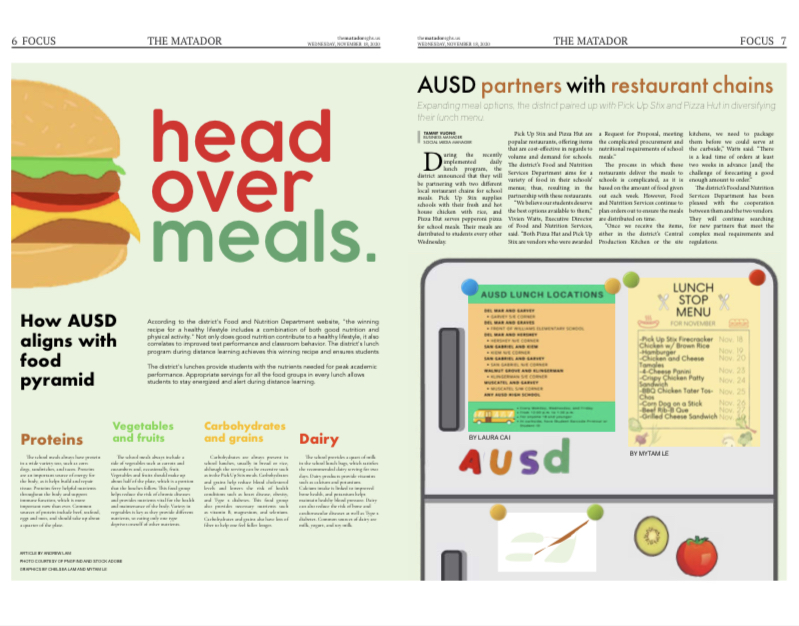
Head over meals
How AUSD aligns with the food pyramid
by Andrew Lam
According to the district’s Food and Nutrition Department website, “the winning recipe for a healthy lifestyle includes a combination of both good nutrition and physical activity.” Not only does good nutrition contribute to a healthy lifestyle, it also correlates to improved test performance and classroom behavior. The district’s lunch program during distance learning achieves this winning recipe and ensures students are at their peak academic performance by providing them with a balance of food groups in their meals.
The school meals always include a side of vegetables such as carrots and cucumbers and, occasionally, fruit. This makes sure that students are receiving the necessary nutrients and vitamins. Vegetables and fruits should make up about half of the plate, which is a portion that the lunches follow. This food group helps reduce the risk of chronic diseases and provides nutrients vital for the health and maintenance of the body. Variety in vegetables is key, as different types of vegetables provide different nutrients, so eating only one type deprives oneself of other nutrients.
The school meals always have protein in a wide variety too, such as corn dogs, sandwiches, and tacos. Proteins are an important source of energy for the body, as it helps build and repair tissue. Proteins ferry helpful nutrients throughout the body and support immune function, which is more important now than ever. Common sources of protein include beef, seafood, eggs, and nuts, and should take up about a quarter of the plate.
Carbohydrates are always present in school lunches, usually in bread or rice, although the serving can be excessive such as in the Pick Up Stix meals. Carbohydrates and grains help reduce blood cholesterol levels and lowers the risk of health conditions such as heart disease, obesity, and Type 2 diabetes. This food group also provides necessary nutrients such as vitamin B, magnesium, and selenium. Carbohydrates and grains also have lots of fiber to help one feel fuller longer.
The school provides a quart of milk in the school lunch bags, which satisfies the recommended dairy serving for two days. Dairy products provide vitamins such as calcium and potassium. Calcium intake is linked to improved bone health, and potassium helps maintain healthy blood pressure. Dairy can also reduce the risk of bone and cardiovascular diseases as well as Type 2 diabetes. Common sources of dairy are milk, yogurt, and soy milk.
The district’s lunches provide students with the nutrients needed for peak academic performance. Appropriate servings for all the food groups in every lunch allows students to stay energized and alert during distance learning.
AUSD partners with restaurant chains
by Tammy Vuong
During the recently implemented daily lunch program, the district announced that they will be partnering with two different local restaurant chains for school meals. Pick Up Stix supplies schools with their fresh and hot house chicken with rice, and Pizza Hut serves pepperoni pizza for school meals. Their meals are distributed to students every other Wednesday.
Pick Up Stix and Pizza Hut are popular restaurants, offering items that are cost-effective in regards to volume and demand for schools. The district’s Food and Nutrition Services Department aims for a variety of food in their schools’ menus; thus, resulting in the partnership with these restaurants.
“We believe our students deserve the best options available to them,” Vivien Watts, Executive Director of Food and Nutrition Services, said. “Both Pizza Hut and Pick Up Stix are vendors who were awarded a Request for Proposal, meeting the complicated procurement and nutritional requirements of school meals.”
The process in which these restaurants deliver the meals to schools is complicated, as it is based on the amount of food given out each week. However, Food and Nutrition Services continue to plan orders out to ensure the meals are distributed on time.
“Once we receive the items, either in the district’s Central Production Kitchen or the site kitchens, we need to package them before we could serve at the curbside,” Watts said. “There is a lead time of orders at least two weeks in advance [and] the challenge of forecasting a good enough amount to order.”
The district’s Food and Nutrition Services Department has been pleased with the cooperation between them and the two vendors. They will continue searching for new partners that meet the complex meal requirements and regulations.
Infographic: AUSD lunch locations
by Laura Cai

Infographic: Lunch stop menu
by Mytam Le
